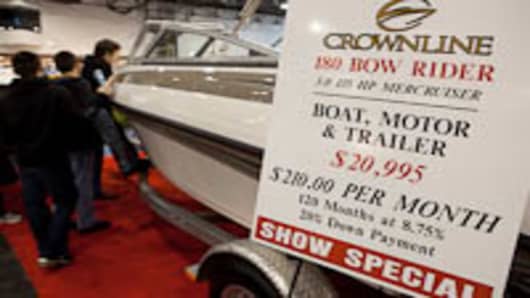Leading up to one of the biggest boat shows of the year — the 2010 Miami International Boat Show — new boat sales appear to be up significantly from last year, with some dealers saying they've sold twice as many boats as they did at the early 2009 shows.
But while it's encouraging to see that buyers of both high-end and entry-level boats are out early, the picture is still incomplete, and the industry has a long way to go before it recovers, experts said.
"Across the industry we believe we're finding the bottom, but we're likely not quite there yet," said Dusty McCoy, CEO of the largest manufacturer of recreational boats, Brunswick .
With experts calling for retail sales to remain flat or drop 10 percent in 2010, boat shows — which account for 65 percent of the industry's sales when including transactions completed as a result of the events — are especially important.
As such, the discretionary boating sector is the latest to try to revive its sales by convincing potential customers, struggling with a high unemployment rate and tighter bank lending conditions, of its affordability.
"The truth is that we always say, 'Now is the best time to buy a boat,' but this time it's really true," said Thom Dammrich, president of the National Marine Manufacturers Association (NMMA) trade group.
A build-up in inventory, caused by a 50 percent decline in new boat sales from the industry's peak, means that for the first time in its 69-year history, the Miami event will allow retailers to display boats other than current-year models. This will provide consumers with more discounts, said Cathy Rick-Joule, show manager and vice president of Southern shows for NMMA.
For the second year, the show will feature about a dozen boats in its Affordability Pavilion, an area reserved for vessels including water ski, pontoon and fishing boats that can all be financed for $250 a month or less.
Manufacturers are offering more features, such as flat-screen TVs, as options, increasing the number of affordable models available to consumers. They've also made adjustments to boats' seating arrangements and decaling to cut back on costs, McCoy said.
That's on top of the fact that shoppers in the market for a boat typically find the best deals at shows, as increased foot traffic makes dealers more willing to drop their prices, she said.
"We have to continue to work through this myth that boating is a rich man's sport, because it's not," Rick-Joule said, pointing out that 75 percent of boat owners have an average household income of less than $100,000 a year. "I don't think we can ever do enough to break that feeling."
Sales at the Miami show have held up better than the rest of the industry — particularly among high-end boats — mainly because of the strong international market it attracts, Rick-Joule said.
Because it's held at the start of the main selling season for most of the country, it's often seen as a measure for how the rest of the year will pan out, Dammrich said.
Though he's optimistic that the industry will rebound, it could take up to five years, he said. Still, he emphasized that even if sales remain flat in 2010, it will still make for a healthier industry than in 2009, when manufacturing was down 70 percent.
For Brunswick, better-controlled inventories will allow the company to nearly halve the 20 percent and larger discounts it offered last year, McCoy said.
"Margins are recovering as the industry is recovering," Dammrich said. "The number of people wanting to buy a boat has not decreased."
More from Consumer Nation:



